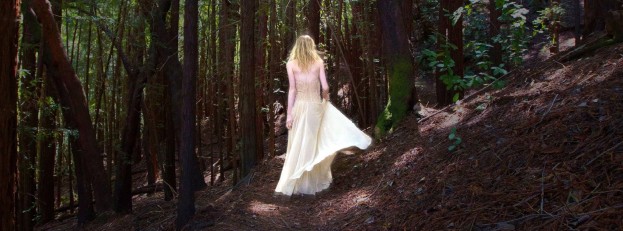CHOREOGRAPHER JULIA ADAM is developing a reputation for site-specific, elegant, sensory-soaked dance experiences that take participants on a gentle yet immersive journey—from food and drink in a communal environment to a traipse through the elements. Her latest work, The Woodland Project, offers an enchanting sojourn through pastoral surroundings and richly imagined art.
Adam, a graduate of the National Ballet School in Toronto, Canada, emerges from a rigorous and traditional academic background, which led her to the National Ballet of Canada and the San Francisco Ballet. After decades of working on traditional stages, she became “tired of the theater. It’s become a sterile environment for me. I’m no longer interested in the fourth wall and the attempts to create a self-contained world and experience in artificial ways.”
Adam, who was also an artistic associate at the Ballet Memphis, gradually became more and more frustrated about challenges that ranged from audience engagement in a dense urban environment to creating community within the confines of art forms that discourage a blurring of the boundaries between stage and audience.
After retiring from the ballet, Adam found inspiration in the natural surroundings of Marin County, where she lives. Open space, air, light, and her experiences traversing the hills in and around her home began to infuse her artistic awareness. “I wanted people to be able to talk to others and not just feel like they were sitting in a dark room watching something on a distant stage,” she says. “I wanted people to talk about the art. So I got to thinking: What if I could bring them to a place where they could engage with the art and each other?”
Adam’s first site-specific choreographed work, The BoatHouse Project, premiered last summer against the backdrop of Tomales Bay. The work arose from a piece that she created previously for Ballet Memphis, entitled Dew Point, which engaged with a series of metaphors for water. She admits that, because it was located in Inverness, audiences’ efforts to get there constituted a kind of pilgrimage. However, she says, “once you got there, I fed you and filled you up. Then you got to sit in a magnificent spot and witness a dance that reflected that place.” The experience, for many, was “holistic and magical.”

The Woodland Project takes her interest in the elements in a slightly different direction. Located in the resplendent woods of Nicasio on the RockRose Ranch, the project includes a number of collaborators (from a composer to a costume designer to a chef).
Adam describes herself as something of a storyteller, so work is seldom abstract. The subtitle for the piece is “The Mycelial Nature of Things,” which refers to the vegetative part of fungus that grows underground in a complex mass of threads and branches, “kind of like underground Wi-Fi that connects everything,” says Adam.
For her new work, eight dancers (six of whom performed in The BoatHouse Project) will bring Adam’s vision to life. This year’s piece will expand on the feasting and communal aspect of last year’s site-specific extravaganza. During that work, audiences enjoyed wine, beer, and appetizers on the beach, and only one of the evenings featured a full farm-to-table dinner. This year, however, each performance will be preceded by a gourmet feast.
Adam’s husband, Aaron Lucich, has been an important collaborator. She notes that he is “fixated on agriculture, soil, and the planet and is connected to West Marin and the farmers there. We have cattle in Santa Rosa that we own and graze, so we have this beautiful grass-fed beef that also helps tie into the themes of the performance.”
Audiences will experience a delectable meal at a custom-made wooden table commodious enough to seat a hundred people, beneath a canopy of trees. Family-style bowls of food will evoke what Adam refers to as “a Renaissance or Medieval feel.” The dancers will also sit down and break bread with the audience, such that there is no hard line between artists and viewers. The epicurean experience is meant to be an integral component of the art, and it also contributes to the sense that the viewing experience is not an anonymous or detached one, but is predicated on a concrete sense of community. Afterwards, everyone will be ushered farther into the grove, to a stage that is closeto the ground and meant to blend into the woodsy environment. Adam’s hope is that audiences will be “titillated by the environment. My hope is that it will be comfortable, cozy, and accessible.”
One of the advantages of performing outdoors is the accidental creation of beauty. During last year’s performance, boats and rolling fog contributed to the picturesque backdrop. “I think that it was very cathartic for a lot of people, as the elements contributed to a sense of release and joy,” Adam says. “This can be hard to provoke in a theater.”
Adam’s collaborators include composer Matthew Pierce, with whom she collaborated extensively while at the San Francisco Ballet. Costume and set designer Christine Darch is offering nature-based designs that reference elements in the dancers’ surroundings while leaving much to the audience’s imagination. Lighting designer Lisa Pinkham’s work will contribute to a sensibility that is simultaneously ethereal and earthy.
Adam’s ultimate hope is that she will someday be able to build a permanent creative home in a beautiful environment that includes a barn-like structure for developing performances. For her, pieces like The Woodland Project are stepping stones toward fulfilling that aesthetic dream.
As soon as The Woodland Project is finished, it’s likely that Adam will get to work on the next project. Although some dance enthusiasts accustomed to more urbane viewing experiences might complain about the trek out to the country, Adam has seen firsthand that the journey is just as important as the destination. “It’s magical out here, and people get a chance to imbibe that.”
This article appeared in the July/August 2015 issue of In Dance.


